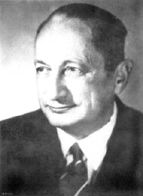

When Kazimierz Kuratowski was born, all secondary schooling in Poland was in Russian. Consequently, he made the decision to study in engineering in Glasgow.
At the end of his first year Kuratowski was awarded the Class Prize in Mathematics. He then studied chemistry at the Technical College during the summer. Because of the outbreak of World War I, returning to Scotland became impossible for Kuratowski.
When the Russians withdrew from Poland, Kuratowski was one of the first students to study mathematics when the University of Warsaw reopened. He attended seminars given by Janiszewski and Mazurkiewicz in Warsaw before the end of the war.
There were two others on the staff at the University of Warsaw who were also to have a major influence on Kuratowski: Lukasiewicz, a professor of
philosophy who worked on mathematical logic, and Sierpinski. In fact the first paper which Kuratowski wrote was On
the definitions in mathematics, written in 1917, which was a consequence of discussions which he had while attending Lukasiewicz's seminar. After graduating
in 1919, Kuratowski undertook his doctoral studies working under Janiszewski and Mazurkiewicz.
In 1921 Kuratowski was awarded his doctorate.
Kuratowski was appointed as a professor at the Technical University of Lvov in 1927.
The mathematicians of Lvov did a great deal of mathematical research in the cafés of the city. The Scottish Café was the most popular with the mathematicians in
general. Kuratowski and Steinhaus sometimes joined their colleagues here.
In Lvov, Kuratowski worked with Banach and they answered some fundamental problems on measure theory. Ulam, who had become Banach's
research student also worked with them.
Kuratowski retained his links with Warsaw while in Lvov, returning each summer to his house outside the capital. In 1934, he left Lvov and became professor of
mathematics at the University of Warsaw. He was to spend the rest of his career at the University of Warsaw although he became involved in mathematical
activities which saw hime travelling world-wide. It was now that Kuratowski began to devote his energies to the cause of Polish mathematics rather than to give all
his efforts to his research. He was still extremely active in research, however, and while spending a month at Princeton in 1936 he wrote a joint paper with von
Neumann. During his time in the United States he also made contact with Robert Moore's topology group, meeting mathematicians who he would keep in contact
with for many years.
After the German invasion of Poland in 1939, the Poles organized an underground
university in Warsaw. Kuratowski risked his life to teach in this illegal educational establishment through the war. At the end of World War II the whole
educational system was destroyed and had to be completely rebuilt. It was Kuratowski who now took on the role of leader in this rebuilding process, through the Polish Mathematical Society of which he was president for 8 years immediately following the war.
The two research institutes, one for pure mathematics and one for applied mathematics, were merged into a plan for a single mathematics institute and accepted in
1948. Kuratowski was appointed the Director of the Mathematical Institute of the Polish Academy of Sciences in 1949. Despite being 53 years of age when
appointed, Kuratowski held this position of director for 19 years. He held other positions of importance in the Polish scientific scene. For example, he was
served as a vice president of the Polish Academy of Sciences.
Kuratowski also played a major role in the publishing of mathematics in general and Polish mathematics in particular. He served on the editorial board of
Fundamenta Mathematicae from 1928, replacing Sierpinski as editor-in-chief in 1952 and continuing in this role for the rest of his life. He was also one of the
founders and an editor of the important Mathematical Monographs series. He contributed the third volume in this series with a monograph on topology.
As an ambassador for Polish mathematics, Kuratowski did a remarkable job with many foreign visits and lecture tours. He lectured in London, Geneva, the U.S., Prague, Berlin, Budapest, Amsterdam, Rome, Peking, Canton, Shanghai, Agra, Lucknow, and Bombay. All this was during the Stalinist era when travel was restricted, and after travel became easier Kuratowski did
indeed take full advantage with many visits to western Europe, Britain, United States, and Canada.
Kuratowski's main work was in the area of topology and set theory. He used the notion of a limit point to give closure axioms to define a topological space. In 1922,
he used Boolean algebra to characterise the topology of an abstract space independently of the notion of points. His work in set theory considered a function as a set of ordered pairs. He also considered the topology of the continuum, the theory of connectivity, dimension theory, and answered measure theory questions.
Other major contributions by Kuratowski were to compactness and metric spaces. He was the author of Topologie, the monograph referred to above, which was the crowning
achievement of the Warsaw School in point set topology. The first volume of this work was the major source on metric spaces for several decades.
His 1930 work on non-planar graphs is of fundamental importance in graph theory. He showed that a graph is planar if and only if it does not contain a subgraph homeomorphic to either K5 or K3,3.
Kuratowski was honoured with many prizes and election to academies. The Academy of Sciences of the Soviet Union, the Hungarian Academy, the Austrian Academy, the
Academy of the German Democratic Republic, the Academy of Sciences of Argentina, the Accademia Nazionale dei Lincei, the Academy of Arts and Letters of
Palermo, and the Royal Society of Edinburgh all elected him to membership. He received honorary degrees from many universities including Glasgow, the
Sorbonne, Prague and Wroclaw.